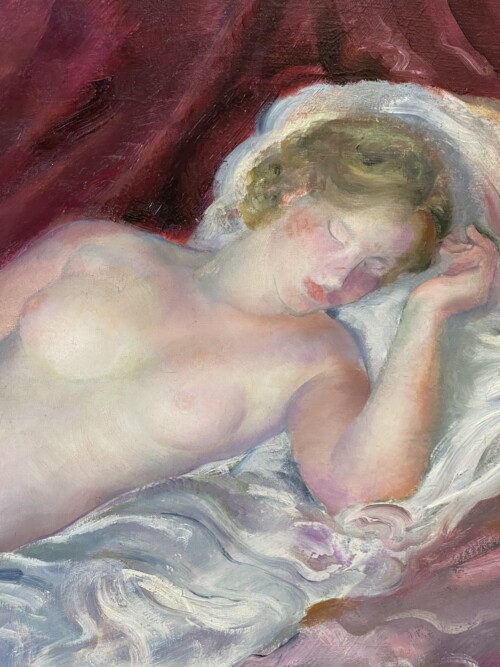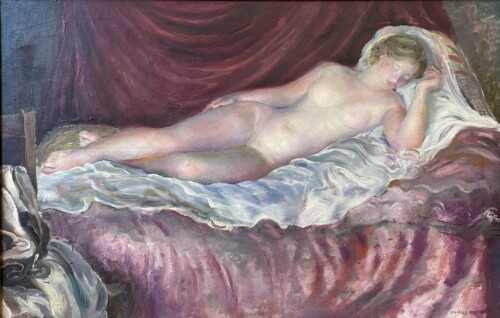-
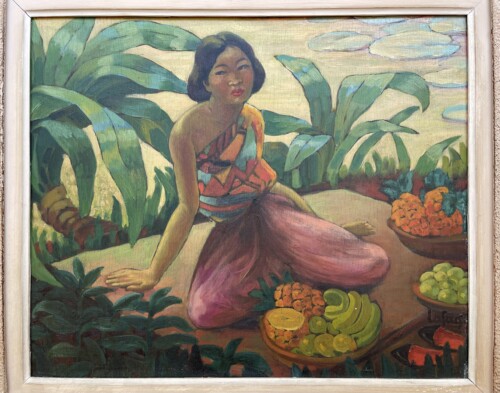
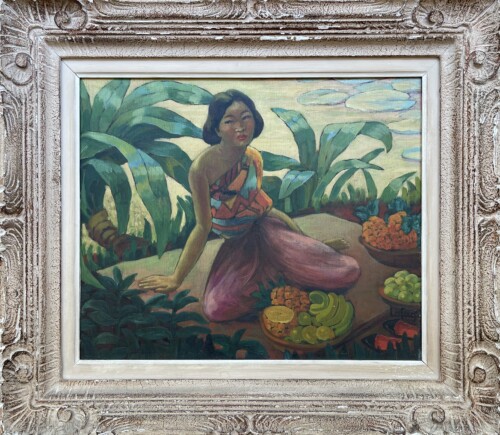 Léa Lafugie (1890-1972) est une peintre qui a voyagé à travers toute l’Asie. Elle est réputée pour ses portraits. Elle a étudié à l’École des Arts Décoratifs, puis à l’École des Beaux-Arts à Paris. Dotée d’un esprit aventurier et curieux, elle décide en 1925 de partir en voyage en Asie, notamment en Chine, en Inde, au Tibet, au Japon et sur la péninsule indochinoise. Elle a laissé de nombreux portraits féminins pris sur le vif lors de ses séjours. Pour référence, nous avons inclus une oeuvre similaire "Les Baigneuses Laotiennes" datant de 1949, ce qui nous permet de donner une date approximative à notre oeuvre. « La marchande de fruits laotienne.» Huile sur panneau. Signée en bas à droite. Encadrée. Circa années 40. Dimensions H : 46 cm ; L : 55,5 cm (sans cadre) H : 66 cm ; L : 75 cm (avec cadre) Léa Lafugie (1890–1972) was a painter who traveled extensively across Asia. She was renowned for her portraits. She studied at the School of Decorative Arts, followed by the École des Beaux-Arts in Paris. With an adventurous and curious spirit, she set off in 1925 on a journey through Asia, visiting countries such as China, India, Tibet, Japan, and the Indochinese Peninsula. During her travels, she created numerous spontaneous portraits of women, capturing them spontaneously. For reference we have included a similar painting "The Laotian Bathers" dating back to 1949, which allows us to pinpoint an approximate date for our painting. "The Laotian Fruit Seller" Oil on panel. Signed at the bottom right. Framed. Circa 1940s. Dimensions H : 46 cm ; W : 55.5 cm (without frame) H : 18 in ; W : 22 in (without frame) H : 66 cm ; W : 75 cm (with frame) H : 26 in ; W : 30 in (with frame)
Léa Lafugie (1890-1972) est une peintre qui a voyagé à travers toute l’Asie. Elle est réputée pour ses portraits. Elle a étudié à l’École des Arts Décoratifs, puis à l’École des Beaux-Arts à Paris. Dotée d’un esprit aventurier et curieux, elle décide en 1925 de partir en voyage en Asie, notamment en Chine, en Inde, au Tibet, au Japon et sur la péninsule indochinoise. Elle a laissé de nombreux portraits féminins pris sur le vif lors de ses séjours. Pour référence, nous avons inclus une oeuvre similaire "Les Baigneuses Laotiennes" datant de 1949, ce qui nous permet de donner une date approximative à notre oeuvre. « La marchande de fruits laotienne.» Huile sur panneau. Signée en bas à droite. Encadrée. Circa années 40. Dimensions H : 46 cm ; L : 55,5 cm (sans cadre) H : 66 cm ; L : 75 cm (avec cadre) Léa Lafugie (1890–1972) was a painter who traveled extensively across Asia. She was renowned for her portraits. She studied at the School of Decorative Arts, followed by the École des Beaux-Arts in Paris. With an adventurous and curious spirit, she set off in 1925 on a journey through Asia, visiting countries such as China, India, Tibet, Japan, and the Indochinese Peninsula. During her travels, she created numerous spontaneous portraits of women, capturing them spontaneously. For reference we have included a similar painting "The Laotian Bathers" dating back to 1949, which allows us to pinpoint an approximate date for our painting. "The Laotian Fruit Seller" Oil on panel. Signed at the bottom right. Framed. Circa 1940s. Dimensions H : 46 cm ; W : 55.5 cm (without frame) H : 18 in ; W : 22 in (without frame) H : 66 cm ; W : 75 cm (with frame) H : 26 in ; W : 30 in (with frame) -
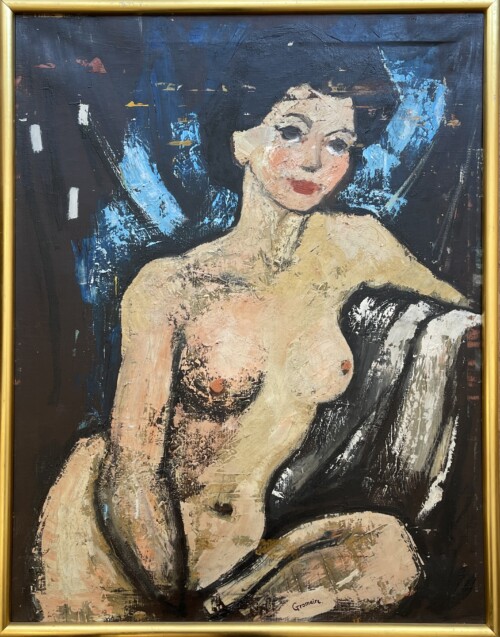 Marcel Gromaire (1892-1971) est un peintre ayant laissé une empreinte importante dans l’art moderne français. Il s’oriente vers la peinture après la Première Guerre mondiale, durant laquelle il a été soldat. Son expérience de la guerre lui apporte une vision à la fois réaliste et monumentale. Ses œuvres, souvent associées à un humanisme social, mettent en valeur le monde du travail et les classes populaires grâce à un style puissant et sobre, avec une influence expressionniste. A son retour de la guerre, il travaille d’abord comme critique de cinéma pour le journal Le Crapouillot. En 1937 il décore le pavillon de la Manufacture de Porcelaine de Sèvres lors de l’Exposition Internationale à Paris, il reçoit notamment le prix Guggenheim en 1956 et le Grand Prix des arts en 1958. « Nu féminin » dans le style de Gromaire. Huile sur toile. Porte une signature non authentifiée en bas au milieu. Ecole française milieu XXème siècle. Dimensions H : 90 cm ; L : 70 cm (sans cadre) H : 93,5 cm ; L : 73,5 cm (avec cadre) Marcel Gromaire (1892–1971) was a painter who left a significant mark on modern French art. He turned to painting after World War I, during which he served as a soldier. His wartime experience gave him a vision that was both realistic and monumental. His works, often associated with social humanism, highlight the world of labor and the working class through a powerful and restrained style, influenced by Expressionism. Upon returning from the war, he initially worked as a film critic for the newspaper Le Crapouillot. In 1937, he decorated the pavilion of the Sèvres Porcelain Manufacture at the International Exposition in Paris. He was awarded the Guggenheim Prize in 1956 and the Grand Prix des Arts in 1958. "Female Nude" in Gromaire’s style. Oil on canvas. Unauthenticated signature at the bottom center. French school of the mid 20th century. Dimensions H : 90 cm ; W : 70 cm (without frame) H : 35 in ; W : 28 in (without frame) H : 93,5 cm ; W : 73,5 cm (with frame) H : 37 in ; W : 29 in (with frame)
Marcel Gromaire (1892-1971) est un peintre ayant laissé une empreinte importante dans l’art moderne français. Il s’oriente vers la peinture après la Première Guerre mondiale, durant laquelle il a été soldat. Son expérience de la guerre lui apporte une vision à la fois réaliste et monumentale. Ses œuvres, souvent associées à un humanisme social, mettent en valeur le monde du travail et les classes populaires grâce à un style puissant et sobre, avec une influence expressionniste. A son retour de la guerre, il travaille d’abord comme critique de cinéma pour le journal Le Crapouillot. En 1937 il décore le pavillon de la Manufacture de Porcelaine de Sèvres lors de l’Exposition Internationale à Paris, il reçoit notamment le prix Guggenheim en 1956 et le Grand Prix des arts en 1958. « Nu féminin » dans le style de Gromaire. Huile sur toile. Porte une signature non authentifiée en bas au milieu. Ecole française milieu XXème siècle. Dimensions H : 90 cm ; L : 70 cm (sans cadre) H : 93,5 cm ; L : 73,5 cm (avec cadre) Marcel Gromaire (1892–1971) was a painter who left a significant mark on modern French art. He turned to painting after World War I, during which he served as a soldier. His wartime experience gave him a vision that was both realistic and monumental. His works, often associated with social humanism, highlight the world of labor and the working class through a powerful and restrained style, influenced by Expressionism. Upon returning from the war, he initially worked as a film critic for the newspaper Le Crapouillot. In 1937, he decorated the pavilion of the Sèvres Porcelain Manufacture at the International Exposition in Paris. He was awarded the Guggenheim Prize in 1956 and the Grand Prix des Arts in 1958. "Female Nude" in Gromaire’s style. Oil on canvas. Unauthenticated signature at the bottom center. French school of the mid 20th century. Dimensions H : 90 cm ; W : 70 cm (without frame) H : 35 in ; W : 28 in (without frame) H : 93,5 cm ; W : 73,5 cm (with frame) H : 37 in ; W : 29 in (with frame) -
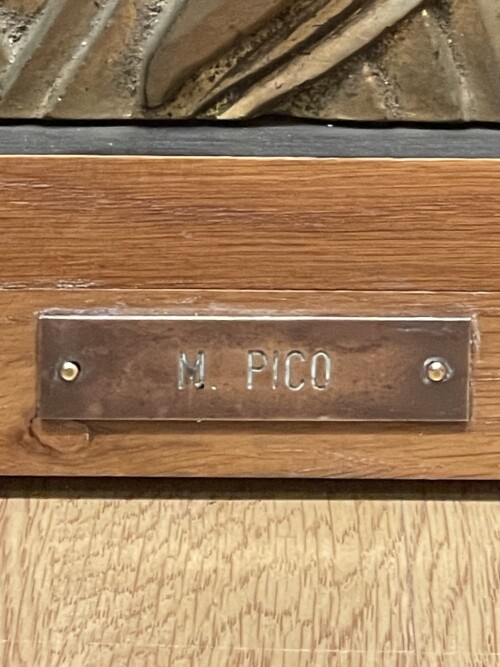
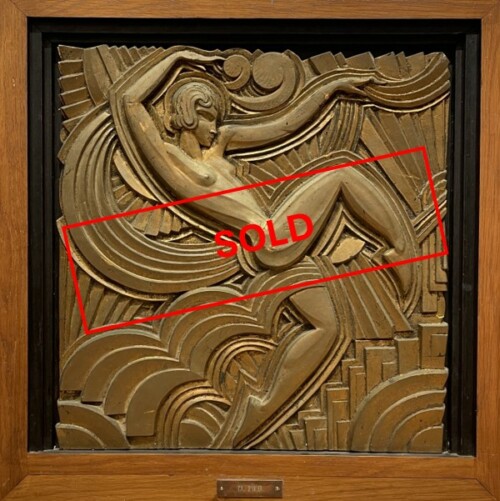 Maurice PICAUD, dit PICO (1900-1977) était un architecte, décorateur et peintre français formé à l'École Boulle. Collaborateur de Jacques-Émile Ruhlmann, il s'est également illustré comme caricaturiste de presse. Parmi ses œuvres ancrées dans l'Art Déco, on compte la célèbre façade des Folies Bergère à Paris (1926), représentant la danseuse russe Lila Nikolska. Il a également réalisé des peintures murales pour l'hôtel de ville de Montdidier dans les années 1930.
Maurice PICAUD, dit PICO (1900-1977) était un architecte, décorateur et peintre français formé à l'École Boulle. Collaborateur de Jacques-Émile Ruhlmann, il s'est également illustré comme caricaturiste de presse. Parmi ses œuvres ancrées dans l'Art Déco, on compte la célèbre façade des Folies Bergère à Paris (1926), représentant la danseuse russe Lila Nikolska. Il a également réalisé des peintures murales pour l'hôtel de ville de Montdidier dans les années 1930.Cette réduction de la façade des Folies Bergère était destinée aux clients les plus importants.
- Bas-relief en stuc doré
- Cadre en bois noirci et chêne avec cartouche M. Pico
- Provenance : collection privée
- Années 30s
Dimensions
H : 62,5 cm L : 63 cm
_________________________________________________________ Maurice PICAUD, known as PICO (1900-1977), was a French architect, decorator, and painter trained at the École Boulle. A collaborator of Jacques-Émile RUHLMANN, he also made a name for himself as a press caricaturist. Among his works rooted in the Art Deco movement, the most famous is the façade of the Folies Bergère in Paris (1926), depicting the Russian dancer Lila Nikolska. He also created murals for the Montdidier town hall in the 1930s.his reduced version of the Folies Bergère façade was intended for the most important clients.
- Gilded stucco bas-relief
- Blackened wood and oak frame with M. Pico cartouche
- Provenance: private collection
- 1930s
Dimensions
H: 24.6 in L: 24.8 in/H: 62.5 cm L: 63 cm
-
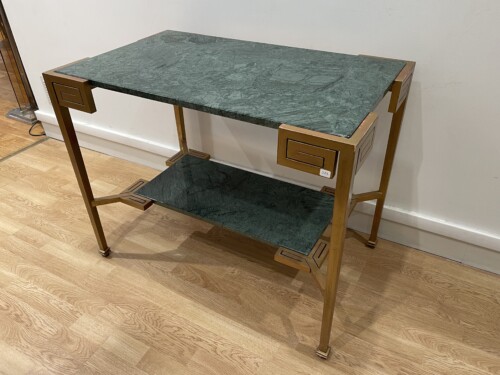
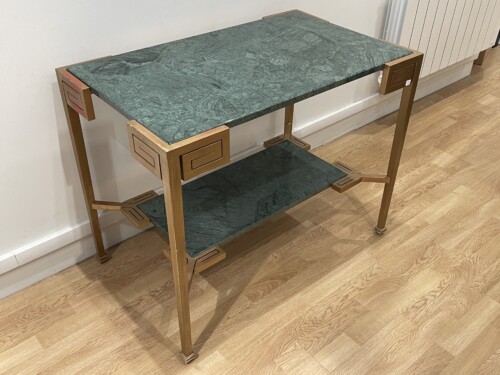 Marcel Coard (1889-1974) est un designer et décorateur français renommé des années 1930. Il se fait connaître grâce à ses meubles raffinés, qui allient simplicité et richesse des matériaux tels que le galuchat, la nacre, le marbre, le bronze, l’ivoire et le parchemin. Sa carrière débute en 1914 avec une commande de Jacques Doucet, un grand collectionneur d’artistes d’Avant-Garde, pour décorer sa maison parisienne. Coard se distingue par sa capacité à manipuler des matériaux rares et à créer des formes innovantes, marquées par des contrastes entre bois sombres et décorations claires.
Marcel Coard (1889-1974) est un designer et décorateur français renommé des années 1930. Il se fait connaître grâce à ses meubles raffinés, qui allient simplicité et richesse des matériaux tels que le galuchat, la nacre, le marbre, le bronze, l’ivoire et le parchemin. Sa carrière débute en 1914 avec une commande de Jacques Doucet, un grand collectionneur d’artistes d’Avant-Garde, pour décorer sa maison parisienne. Coard se distingue par sa capacité à manipuler des matériaux rares et à créer des formes innovantes, marquées par des contrastes entre bois sombres et décorations claires.- Structure en fer doré, à décor de grecque à chaque angle de la ceinture
- Pieds gaine réunis pas une tablette d’entrejambe enrichie de grecques
- Plateaux en marbre ver-de-mer
- Signée du cachet et du perroquet sur un montant
- Très bon état, traces d’usures et rayures sur la dorure (voir photos)
- Gilt iron structure, decorated with Greek key motifs at each corner of the apron
- Tapered legs connected by a stretcher shelf adorned with Greek key motifs
- Ver-de-mer marble tops
- Signed with the maker's stamp and the parrot mark on one upright
- Very good condition, with signs of wear and scratches on the gilding (see photos)
-
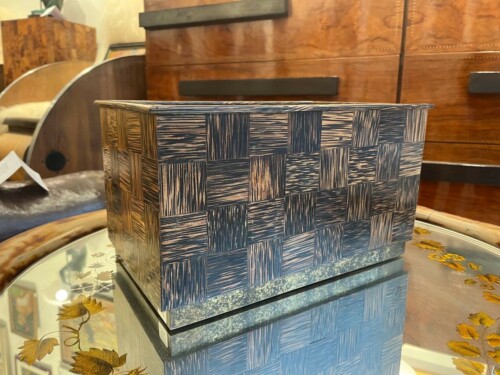
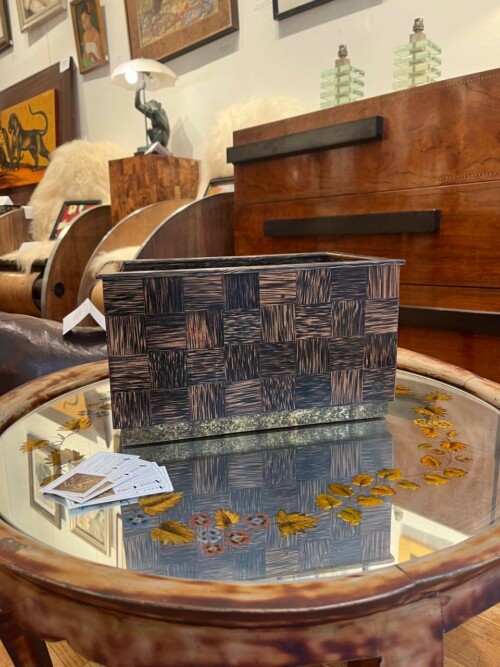 Eugène PRINTZ (1879 – 1948), formé dans l'atelier de son père à Paris, se tourne dès les années 1920 vers la création de meubles modernes. Printz était un des grands maitres ébénistes de la période Art Déco. Il collabore avec Pierre Chareau à l'Exposition des Arts Décoratifs de 1925 et participe à de nombreux salons, comme le Salon des Artistes Décorateurs et l'Exposition Coloniale de 1931. Il travaille pour des clients fortunés, des institutions comme le Mobilier National et la Ville de Paris et se distingue notamment par l'utilisation du bois de palmier, un matériau rare.
Eugène PRINTZ (1879 – 1948), formé dans l'atelier de son père à Paris, se tourne dès les années 1920 vers la création de meubles modernes. Printz était un des grands maitres ébénistes de la période Art Déco. Il collabore avec Pierre Chareau à l'Exposition des Arts Décoratifs de 1925 et participe à de nombreux salons, comme le Salon des Artistes Décorateurs et l'Exposition Coloniale de 1931. Il travaille pour des clients fortunés, des institutions comme le Mobilier National et la Ville de Paris et se distingue notamment par l'utilisation du bois de palmier, un matériau rare.- Bois de palmier
- Cachet Printz en bois debout
- Laiton oxydé à l’acide
- Palmwood
- Printz stamp in end-grain wood
- Acid-oxidized brass
-
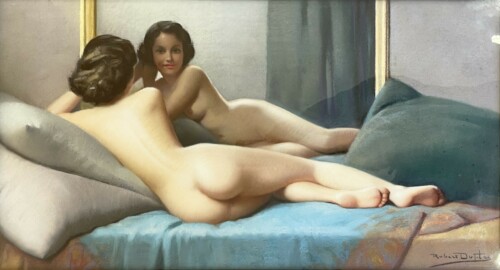
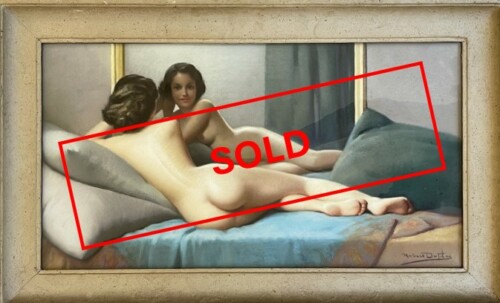 Robert Duflos fut une peintre extrêmement précoce dont l’œuvre est essentiellement constituée de pastels et de nus extrêmement aboutis. Son œuvre est concentrée sur une décennie (les années 20) car il disparut très jeune, à 31 ans.
Robert Duflos fut une peintre extrêmement précoce dont l’œuvre est essentiellement constituée de pastels et de nus extrêmement aboutis. Son œuvre est concentrée sur une décennie (les années 20) car il disparut très jeune, à 31 ans.- Pastel.
- Signé en bas à droite.
- Ancien cadre.
- Années 20.
-
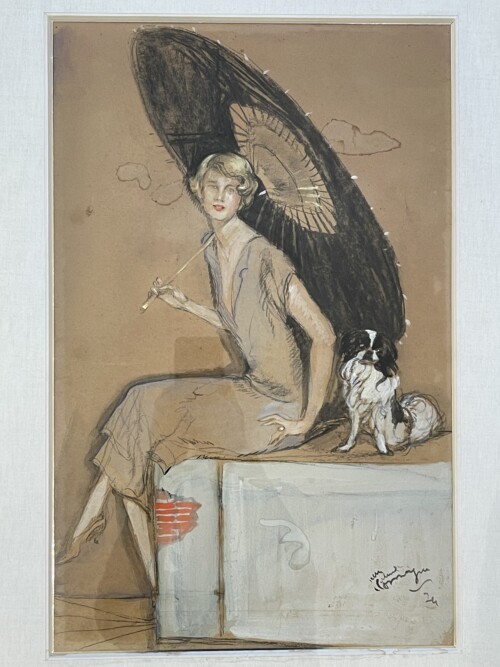
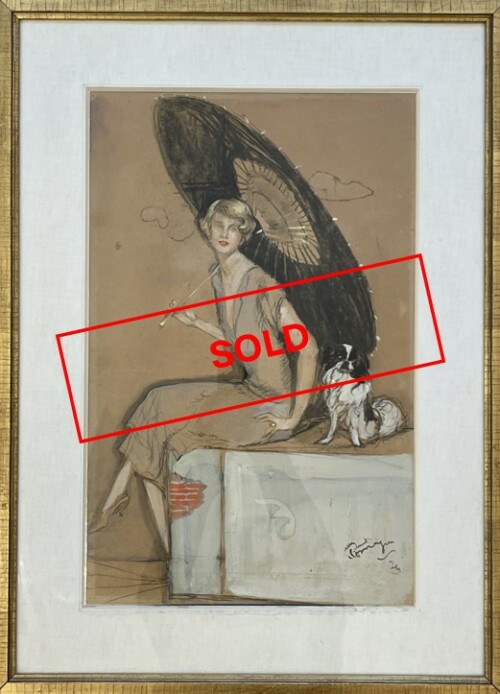 Jean-Gabriel Domergue, fut un peintre et graveur français renommé, particulièrement pour ses portraits de femmes élégantes ou plutôt pour un personnage féminin dans un style qui s’est affirmé au fil du temps, clairement reconnaissable et marqué par l'Art Déco. Petit-cousin de Toulouse-Lautrec, il a étudié aux Beaux-Arts de Paris et a exposé dès 1906 au Salon des artistes français, où il a remporté plusieurs distinctions, dont un deuxième grand prix de Rome en 1913. En 1939, il a réalisé l'affiche iconique du premier Festival de Cannes, finalement annulé, montrant une femme applaudissant aux côtés d’un homme en habit. En 1950, il a été élu à l’Institut de France et est devenu conservateur du musée Jacquemart-André, où il organisait des grandes expositions.
Jean-Gabriel Domergue, fut un peintre et graveur français renommé, particulièrement pour ses portraits de femmes élégantes ou plutôt pour un personnage féminin dans un style qui s’est affirmé au fil du temps, clairement reconnaissable et marqué par l'Art Déco. Petit-cousin de Toulouse-Lautrec, il a étudié aux Beaux-Arts de Paris et a exposé dès 1906 au Salon des artistes français, où il a remporté plusieurs distinctions, dont un deuxième grand prix de Rome en 1913. En 1939, il a réalisé l'affiche iconique du premier Festival de Cannes, finalement annulé, montrant une femme applaudissant aux côtés d’un homme en habit. En 1950, il a été élu à l’Institut de France et est devenu conservateur du musée Jacquemart-André, où il organisait des grandes expositions.- Technique mixte (crayon, fusain, aquarelle et gouache).
- Signé en bas à droite et daté 1924.
- Papier légèrement insolé, petits pliures sur les bordures, quelques taches.
- Encadré sous verre.
Jean-Gabriel Domergue (1889–1962) was a renowned French painter and engraver, celebrated especially for his portraits of elegant women or, more precisely, a feminine figure in a style that evolved over time, clearly recognizable, marked by Art Deco. A distant cousin of Toulouse-Lautrec, he studied at the École des Beaux-Arts in Paris and began exhibiting at the Salon des Artistes Français as early as 1906, where he earned several distinctions, including a second Grand Prix de Rome in 1913. In 1939, he created the iconic poster for the inaugural Cannes Film Festival, which was ultimately canceled, depicting a woman applauding beside a man in formal attire. In 1950, he was elected to the Institut de France and became the curator of the Jacquemart-André Museum, where he organized major exhibitions.- Mixed media (pencil, charcoal, watercolor, and gouache).
- Signed lower right and dated 1924.
- Paper slightly faded, small creases along edges, some spots.
- Framed under glass.
- H: 49.5 cm W: 31.5 cm/ H: 19.5 in W: 12.4 in (at sight)
-
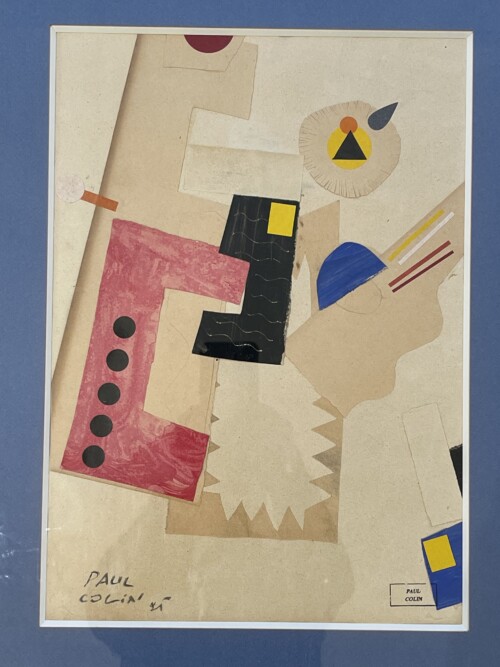
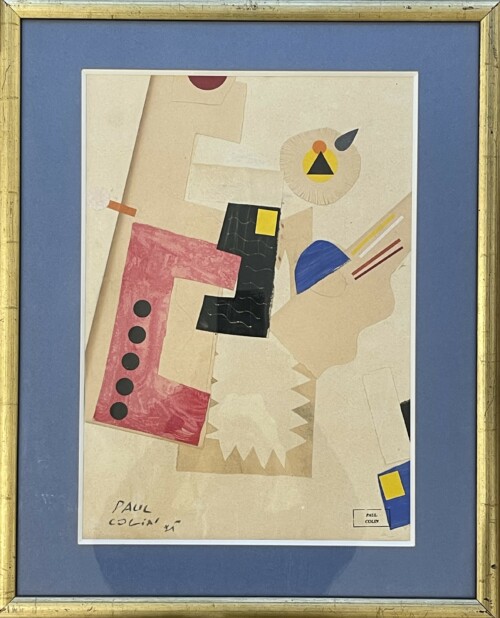 Paul Colin (1892 – 1986), peintre, dessinateur, scénographe et affichiste majeur du XXe siècle, reconnu pour son influence sur l’Art déco. Il grandit à Nancy, un centre artistique d'Avant-Garde et développe un intérêt pour la peinture. Avant la Première Guerre mondiale, il fonde avec Jean Lurçat la revue La Vache enragée. Sa carrière prend un tournant en 1925 lorsqu’il crée une affiche illustrant Joséphine Baker et marquant l’histoire de l'affiche par ses éléments cubistes traduisant le rythme du jazz. Ce succès le consacre comme une figure des "années folles" et l’amène à organiser le Bal Blomet en 1927, pour lequel il réalise une nouvelle affiche emblématique. Colin se diversifie ensuite en réalisant décors et costumes pour le théâtre et le cinéma. S’inspirant du cubisme pour capturer le dynamisme moderne, il adapte son propre style remarquable.
Paul Colin (1892 – 1986), peintre, dessinateur, scénographe et affichiste majeur du XXe siècle, reconnu pour son influence sur l’Art déco. Il grandit à Nancy, un centre artistique d'Avant-Garde et développe un intérêt pour la peinture. Avant la Première Guerre mondiale, il fonde avec Jean Lurçat la revue La Vache enragée. Sa carrière prend un tournant en 1925 lorsqu’il crée une affiche illustrant Joséphine Baker et marquant l’histoire de l'affiche par ses éléments cubistes traduisant le rythme du jazz. Ce succès le consacre comme une figure des "années folles" et l’amène à organiser le Bal Blomet en 1927, pour lequel il réalise une nouvelle affiche emblématique. Colin se diversifie ensuite en réalisant décors et costumes pour le théâtre et le cinéma. S’inspirant du cubisme pour capturer le dynamisme moderne, il adapte son propre style remarquable.- Collage et gouache sur papier.
- Signé en bas à gauche et daté 1925.
- Cachet d’atelier en bas à droite.
Paul Colin (1892–1986), a painter, illustrator, set designer, and major poster artist of the 20th century, is renowned for his influence on Art Deco. He grew up in Nancy, a hub of avant-garde art, where he developed an interest in painting. Before World War I, he founded the magazine La Vache enragée with Jean Lurçat. His career took a pivotal turn in 1925 when he created a poster featuring Josephine Baker, making history with its cubist elements that captured the rhythm of jazz. This success established him as a key figure of the "Roaring Twenties" and led him to organize the Bal Blomet in 1927, for which he designed another iconic poster. Colin later expanded his work into theater and film, creating set designs and costumes. Drawing from cubism to express modern dynamism, he adapted his own remarkable style.- Collage and gouache on paper.
- Signed at lower left and dated 1925.
- Studio stamp at lower right.
-
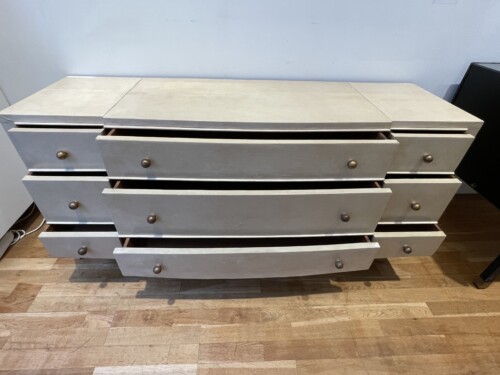
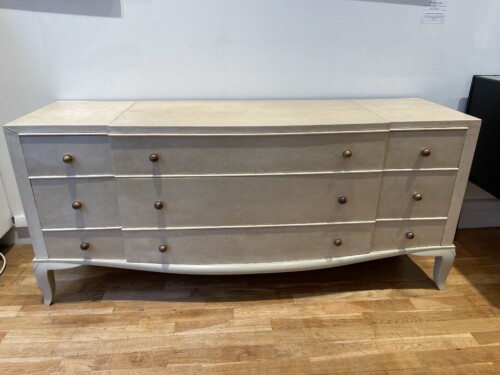 André Arbus (1903-1969), ébéniste et décorateur français, est reconnu pour son style néo-classique raffiné qui marie élégance et tradition. Formé aux Beaux-Arts et enraciné dans l'artisanat familial, il se distingue dès l’Exposition Internationale des Arts Décoratifs de 1925. Fidèle à l'héritage français, il travaille des matériaux nobles comme le sycomore et la laque, et orne ses pièces de détails sculptés inspirés de l'époque classique. Arbus conçoit des meubles à la fois somptueux et fonctionnels, portant l’empreinte d'une tradition revisitée avec modernité et finesse.
André Arbus (1903-1969), ébéniste et décorateur français, est reconnu pour son style néo-classique raffiné qui marie élégance et tradition. Formé aux Beaux-Arts et enraciné dans l'artisanat familial, il se distingue dès l’Exposition Internationale des Arts Décoratifs de 1925. Fidèle à l'héritage français, il travaille des matériaux nobles comme le sycomore et la laque, et orne ses pièces de détails sculptés inspirés de l'époque classique. Arbus conçoit des meubles à la fois somptueux et fonctionnels, portant l’empreinte d'une tradition revisitée avec modernité et finesse.- Entièrement recouverte de parchemin.
- Circa 1935.
- Une variante au modèle a été acquise par le Mobilier National et présentée lors de l'exposition “Le Chic ! Arts décoratifs et mobilier de 1930 à 1960” à la Galerie des Gobelins en 2023
- Neuf tiroirs.
André Arbus (1903-1969), a French cabinetmaker and decorator, is recognized for his refined neoclassical style that blends elegance and tradition. Trained at the Beaux-Arts and rooted in his family's craftsmanship, he distinguished himself at the International Exhibition of Decorative Arts in 1925. Faithful to French heritage, he works with noble materials such as sycamore and lacquer, adorning his pieces with sculpted details inspired by classical times. Arbus designs furniture that is both sumptuous and functional, bearing the mark of a tradition reinterpreted with modernity and finesse.- Completely covered in parchment.
- Circa 1935.
- One model was acquired by the Mobilier National and presented in the exhibition “Le Chic! Decorative Arts and Furniture from 1930 to 1960” at the Galerie des Gobelins, 2023.
- Nine drawers.
-
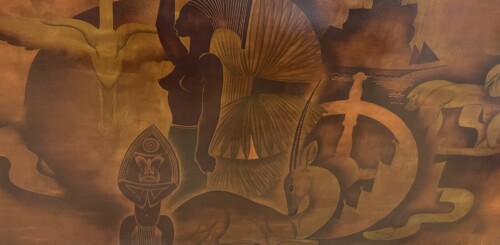
 Exploration de l'Afrique.
Exploration de l'Afrique.- Laque sur panneau.
- Circa 1940.
- Signé en bas à droite.
- Laquer on board.
- Circa 1940.
- Signed in the bottom right corner.
-
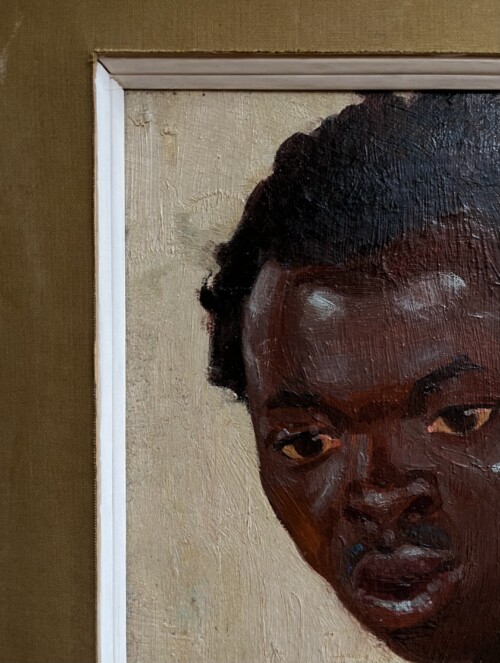
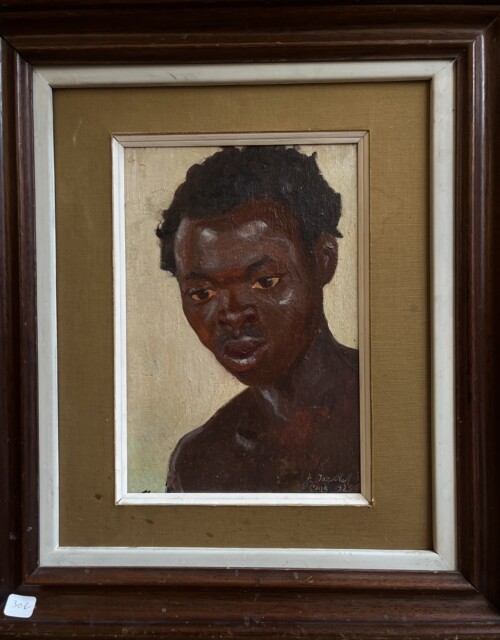 Alexandre Iacovleff (1887–1938), né à Saint-Pétersbourg et naturalisé français, fut un peintre russe de renom. Fils d’un officier de marine, il étudia à l'Académie impériale des beaux-arts de Saint-Pétersbourg sous la direction de Dmitri Kardovski, où il se lia d’amitié avec Vassili Choukhaïev. Actif dans le mouvement Mir Iskousstva, il quitta la Russie en 1917 pour l'Asie, voyageant en Chine et au Japon. Installé à Paris en 1920, il se distingue par ses expositions et publications, dont « Dessins & Peintures d’Extrême-Orient ». En 1924, il devient le peintre officiel de la Croisière noire, traversant l’Afrique et produisant 300 dessins. Suivant son succès, il réalise les décors du ballet « Sémiramis » à l’Opéra de Paris et dirige l'école de dessin du musée des beaux-arts de Boston. Cette peinture est l'un des portraits réalisés par Alexandre Iacovleff durant son voyage avec la Croisière noire. Elle illustre un homme congolais.
Alexandre Iacovleff (1887–1938), né à Saint-Pétersbourg et naturalisé français, fut un peintre russe de renom. Fils d’un officier de marine, il étudia à l'Académie impériale des beaux-arts de Saint-Pétersbourg sous la direction de Dmitri Kardovski, où il se lia d’amitié avec Vassili Choukhaïev. Actif dans le mouvement Mir Iskousstva, il quitta la Russie en 1917 pour l'Asie, voyageant en Chine et au Japon. Installé à Paris en 1920, il se distingue par ses expositions et publications, dont « Dessins & Peintures d’Extrême-Orient ». En 1924, il devient le peintre officiel de la Croisière noire, traversant l’Afrique et produisant 300 dessins. Suivant son succès, il réalise les décors du ballet « Sémiramis » à l’Opéra de Paris et dirige l'école de dessin du musée des beaux-arts de Boston. Cette peinture est l'un des portraits réalisés par Alexandre Iacovleff durant son voyage avec la Croisière noire. Elle illustre un homme congolais.- Huile sur panneau.
- Signée en bas à droite et datée en 1925, situé au Congo.
- Oil on panel.
- Signed in the down right corner and dated 1925, located in Congo.
